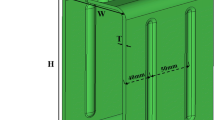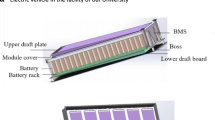Abstract
Purpose
A study of vibration attenuation of a vehicle occupant needs to start by integrating models of human body, cushion, seat suspension and vehicle. The latter needs to be carefully chosen to get the right balance between modelling complexity and prediction accuracy. This work considers two simplified vehicle models (quarter and half car) and studies how much the predictions of these models deviate from that of the full car model.
Methods
The seat suspension parameters were chosen to be those which minimized seat effective amplitude transmissibility. A genetic algorithm based optimization procedure was used for this exercise. A total of 28 model response parameters were investigated which included accelerations of different sections of the body and seat suspension, forces generated due to contact of the body with the seat and the backrest, forces and moments at the internal joints of the body and seat effective amplitude transmissibility.
Results
It was seen that when the input to the system was the random disturbances from an irregular road, the predictions of the quarter car model were distinctly different from those of the full car model while the half car model gave acceptable results in a few cases. However, when the input condition was changed to a bump on the road, the apparent superiority of the half car model was less prominent.
Conclusion
Thus, for a random road profile, it is better to choose the half car as a simplified vehicle model. For a bump road profile, the quarter car model, which is considerably simpler, maybe preferred if computing time or complexity is a constraint.

















Similar content being viewed by others
References
Azizan A, Fard M, Azari MF, Jazar R (2017) Effects of vibration on occupant driving performance under simulated driving conditions. Appl Ergon 60:348–355
Hill TE, Desmoulin GT, Hunter CJ (2009) Is vibration truly an injurious stimulus in the human spine? J Biomech 42:2631–2635
Marzbanrad J, Shakhlavi SJ, Moghaddam IT, Afkar A (2018) Biomechanical modeling of a seated human body exposed to vertical and horizontal vibrations using genetic algorithms. J Vib Eng Technol 6:417–426
Guruguntla V, Lal M (2020) An improved biomechanical model to optimize biodynamic responses under vibrating medium. J Vib Eng Technol 15:1–11
Valentini PP, Pennestrì E (2016) An improved three-dimensional multibody model of the human spine for vibrational investigations. Multibody Syst Dyn 36:363–375
Desai R, Guha A, Seshu P (2019) Multibody biomechanical modelling of human body response to vibrations in an automobile, in: IFToMM World Congr. Mech Mach Sci 3–12
Desai R, Guha A, Seshu P (2021) Multibody modeling of direct and cross-axis seat to head transmissibility of the seated human body supported with Backrest and exposed to vertical vibrations. Mech Mach Sci. https://doi.org/10.1007/978-981-15-4477-4_9
Desai R, Guha A, Seshu P (2018) Multibody biomechanical modelling of human body response to direct and cross axis vibration. Procedia Comput Sci 133:494–501
Desai R, Guha A, Seshu P (2020) Multibody modelling of the human body for vibration induced direct and cross-axis seat to head transmissibility. Proc Inst Mech Eng Part C J Mech Eng Sci. https://doi.org/10.1177/0954406220967957
Desai R, Guha A, Seshu P (2020) Modelling and simulation of an integrated human-vehicle system with non-linear cushion contact force. Simul Model Pract Theory 102206
Zuo L, Nayfeh SA (2003) Structured H2 optimization of vehicle suspensions based on multi-wheel models. Veh Syst Dyn 40:351–371
Jamadar M-H, Desai RM, Saini RST, Kumar H, Joladarashi S (2020) Dynamic analysis of a quarter car model with semi-active seat Suspension using a novel model for magneto-rheological (MR) damper. J Vib Eng Technol. https://doi.org/10.1007/s42417-020-00218-1
Rajendiran S, Lakshmi P (2020) Performance analysis of fractional order terminal SMC for the half car model with random road input. J Vib Eng Technol 8:587–597
Desai R, Guha A, Seshu P (2021) Modelling and simulation of an integrated human-vehicle system with non-linear cushion contact force. Simul Model Pract Theory. vol,106. https://doi.org/10.1016/j.simpat.2020.102206
Wang W, Rakheja S, Boileau P-É (2006) Effect of back support condition on seat to head transmissibilities of seated occupants under vertical vibration. J Low Freq Noise Vib Act Control. 25:239–259
Wu X, Rakheja S, Boileau P-É (1999) Study of human-seat interactions for dynamic seating comfort analysis. In: SAE Tech Pap. Ser SAE pp. 1–11
Maciejewski I, Krzyzynski T, Meyer H (2018) Modeling and vibration control of an active horizontal seat suspension with pneumatic muscles. J Vib Control 24:5938–5950
Desai R, Guha A, Seshu P (2020) A comparison of different models of passive seat suspensions. Part D J. Automob, Eng
Czop P, Sławik D, Wszołek G (2013) Development of an optimization method for minimizing vibrations of a hydraulic damper. Simulation 89:1073–1086
Rakheja S, Boileau P-É, Wang Z (2004) Performance analysis of suspension seats under high magnitude vibration excitations: II. Design parameter study. J Low Freq Noise Vib Act Contro. 23:7–25
Wu X, Rakheja S, Boileau P-É (1999) Dynamic performance of suspension seats under vehicular vibration and shock excitations. SAE Trans 108:2398–2410
Alfadhli A, Darling J, Hillis A (2018) An active seat controller with vehicle suspension feedforward and feedback states: an experimental study. Appl Sci 8:603
Nigam NC, Narayanan S (1994) Applications of random vibrations. Springer, Cham
Zhang L-J, Lee C-M, Wang YS (2002) A study on nonstationary random vibration of a vehicle in time and frequency domains. Int J Automot Technol 3:101–109
Khorshid E, Alkalby F, Kamal H (2007) Measurement of whole-body vibration exposure from speed control humps. J Sound Vib 304:640–659
Du H, Li W, Zhang N (2012) Integrated seat and suspension control for a quarter car with driver model. IEEE Trans Veh Technol 61:3893–3908
Vibration M (1997) Shock—Evaluation of human exposure to whole-body vibration—Part 1: General Requirements, ISO Stand. 2631
Wang YH, Shih MC (2011) Design of a genetic-algorithm-based self-tuning sliding fuzzy controller for an active suspension system. Proc Inst Mech Eng Part I J Syst Control Eng. 225:367–383
Desai R, Guha A, Seshu P (2020) Investigation of Internal Human Body Dynamic Forces Developed During a Vehicle Ride. Int Conf IFToMM ITALY. Springer, Cham, pp 85–93
Winter DA (2009) Biomechanics and motor control of human movement. John Wiley & Sons, Hoboken
Chandler RF, Clauser CE, McConville JT, Reynolds HM, Young JW (1975) Investigation of inertial properties of the human body
Author information
Authors and Affiliations
Corresponding author
Ethics declarations
Conflict of interest
On behalf of all authors, the corresponding author states that there is no conflict of interest.
Additional information
Publisher's Note
Springer Nature remains neutral with regard to jurisdictional claims in published maps and institutional affiliations.
Appendix
Appendix
See below Tables 5, 6, 7, 8 and 9.
Rights and permissions
About this article
Cite this article
Desai, R., Guha, A. & Seshu, P. A Comparison of Quarter, Half and Full Car Models for Predicting Vibration Attenuation of an Occupant in a Vehicle. J. Vib. Eng. Technol. 9, 983–1001 (2021). https://doi.org/10.1007/s42417-020-00278-3
Received:
Revised:
Accepted:
Published:
Issue Date:
DOI: https://doi.org/10.1007/s42417-020-00278-3




